What to visit in Trieste: the 8 most beautiful places!
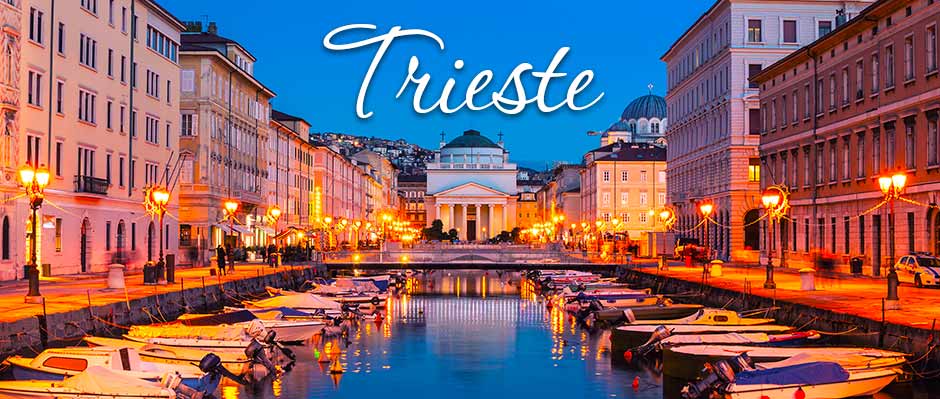
European Capital of Science in 2020, sea and wind, Cafés and writers. Let’s discover which are the 8 things not to be missed in Trieste with Vip Limousine.
Thanks to its geographical position, Trieste has always been a meeting point of cultures and religions. A boarder city and a syntax of Middle-European and Mediterranean character, Trieste has been hosting various foreigner communities and ethnic minorities that contributed to make it culturally richer: probably it was the dynamic climate that fed the numerous artists and intellectuals that inhabited it, such as the Irish writer James Joyce.
In 2020 Trieste will be the European Capital of Science, but at the moment is enjoying the fame of the city of wind, historic Cafés and many museums. It has always been a multicultural city that has distinguished itself also for University research conducted by the SISSA, the International School for Advanced Studies.
There are many things to be visited in Trieste and here we give you some examples!
Vip Limousine, Luxury car rental with driver in Milano, is always with you! Even if it is for a business or a pleasure trip, we’ll be available 24 hours a day to listen your desires and make them real, creating a personalised itineraries, suitable with your needs. Don’t hesitate to contact us, we’ll be there to pick you up with the car you prefer, at the station or at the airport and we’ll bring you in Trieste to start the tour studied just for you!
1 - Piazza Unità and Molo Audace
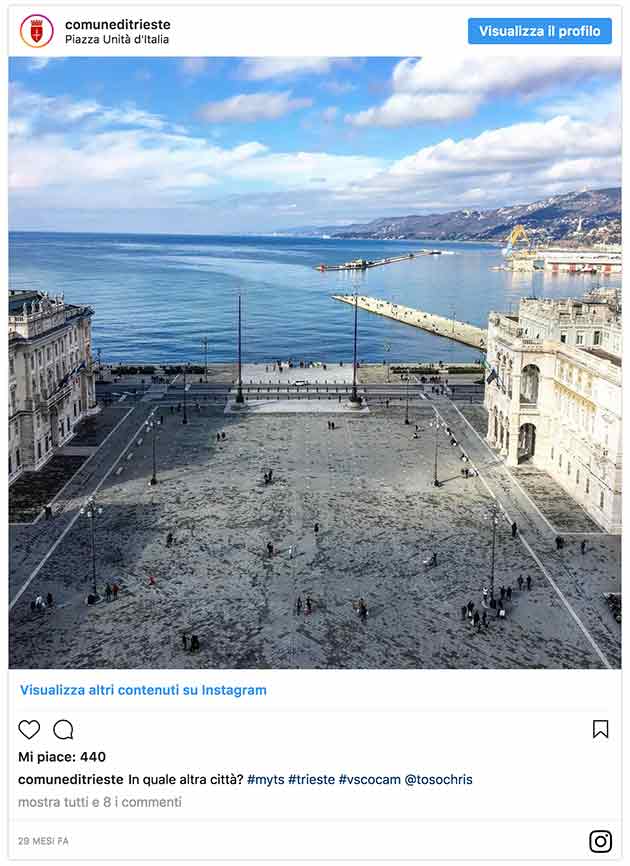
Recalling all the names this big square had through the centuries, you realise how troubled is the history of Trieste: it has always been a point of contention.
The square was born with the name Piazza San Pietro due to the presence of a little Church; later it became Piazza Grande and only in 1918 it was called Piazza Unità.
Just after the end of the World War II and the return to Italy of the “Free Territory of Trieste“, it took the definitive name Piazza Unità d’Italia. The inhabitants of Trieste are prising that it is the biggest square overlooking the sea in Europe.
From the left to the right we see: Palazzo della Luogotenenza austriaca (palace of the Austrian lieutenancy) seat of the Prefecture, Palazzo Stratti with the famous Caffè degli Specchi, Palazzo Modello seat of the Municipality, Palazzo Pitteri (the most ancient of the square), the hotel in Palazzo Vanoli and Palazzo della Regione property of the shipping company Lloyd Triestino.
In the square you can see also the Fontana dei Quattro Continenti (Fountain of the four continents) built between 1751 and 1754: the figures are an allegory of the four continents then known (Europe, Asia, Africa and America).
In front of the square you can see the Molo Audace (bold dock) taking the name from the first ship that succeeded to enter in the port of Trieste after the end of the World War I and the consequent annexation to Italy.
The bronze wind rose present on the dock was obtained by the melting of an Austrian ship sank by the Italian fleet.
2 - Canal Grande, Ponte Rosso and the Statue of James Joyce
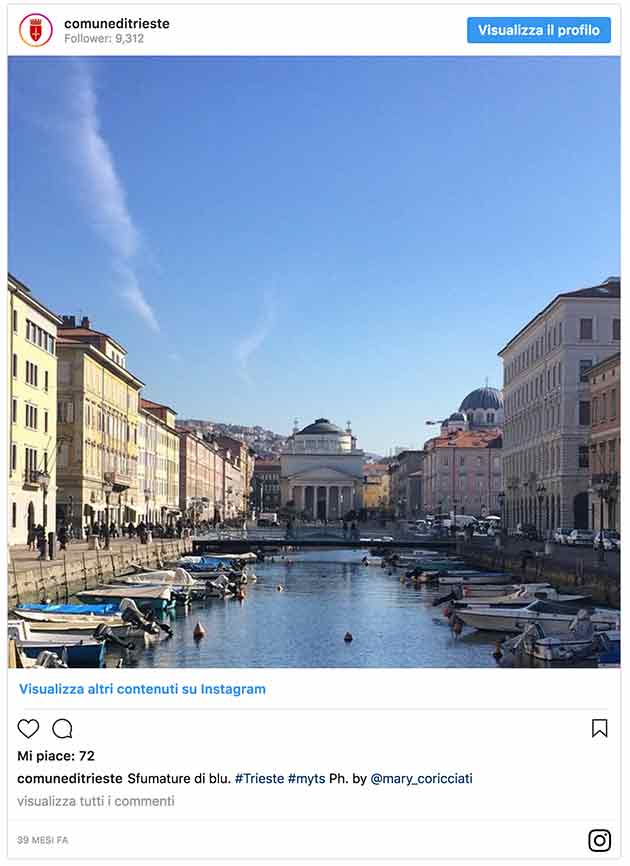
Another of the most important attractions of Trieste is for sure the Canal Grande: one of the symbol places of the city, used to get the goods to the port by water.
The Canal Grande, in the heart of Trieste and on the border between Borgo Giuseppino and Borgo Teresiano, is navigable and was realised in the second half of the 18th century. It still represents the pulsating heart of the city of Trieste and at the same time a perfect image of its past and recent history.
On the canal underlining the tight bond between Trieste and the sea, are facing many Churches recalling the different rituals in the city.
The canal is crossed by 2 bridges: ponte Verde and ponte Rosso, where you can meet James Joyce, or better, the statue representing him walking, while Piazza Hortis hosts the bronze statue of Italo Svevo.
In Via San Nicolò you can see a statue dedicated to Umberto Saba, born in Trieste as Svevo.
Moreover, some of the most beautiful palaces of Trieste are facing the canal as Palazzo Gopcevic and Palazzo Carciotti respectively abodes of some historic families of the city.
Not everybody knows that at the corner of the quay under the ponte Rosso is still visible, if you pay attention, a hygrometer sculpted in the stone and graduated in Parisian feet and inches. The zero in this hygrometer is known in the scientific world as the "Zero Ponte Rosso".
My soul is in Trieste. (James Joyce)
3 - The Miramare Castle
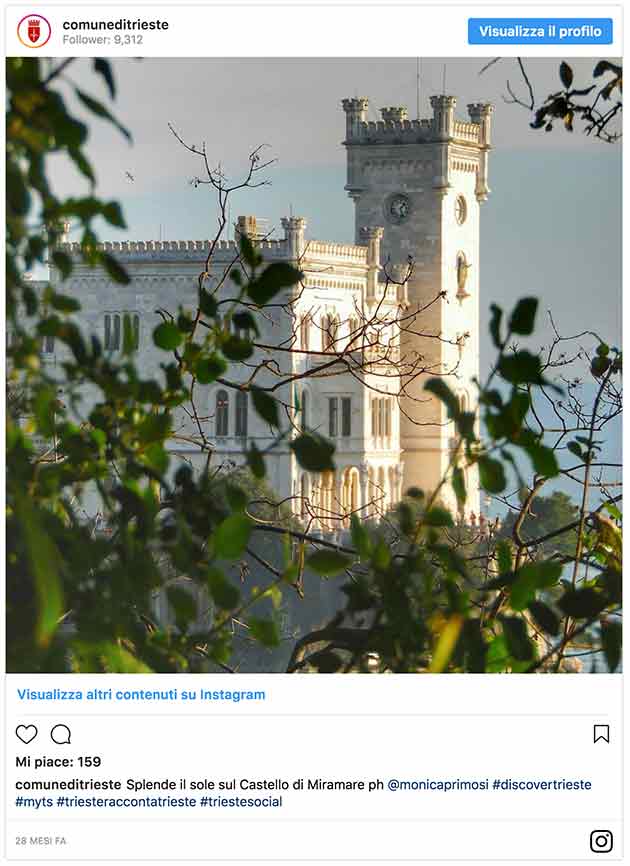
“Nido d’amore costruito in vano” (a love nest built in vain): thus Giosuè Carducci calls the Miramare Castle. It was wanted in 1850 by the archduke Ferdinando Massimiliano d’Asburgo in order to make it the abode for him and his consort Carlotta del Belgio.
Overlooking the sea and with wide green spaces, it was the ideal solution for the Archduke, expert seafaring man and botanic lover.
But Miramare never became the love nest for the royal couple because Massimiliano was soon killed in Mexico.
Carlotta, grieved for her loss, lived in the nearby castle for some years until she moved in Belgium.
The eclectic style of the palace mixing Gothic, Renaissance and Medieval elements, is able to fascinate all visitors.
On the ground floor you can visit the apartments of Carlotta and Massimiliano, while at the first floor are situated the guest apartments.
The enormous park is today one of the preferred places of the people living in Trieste that go there for walking, jogging or sun bathing.
The ideal solution would be to arrive at Miramare through the seafront of Barcola that, directly from the centre, brings to the Castello Miramare.
4 - The San Giusto Cathedral
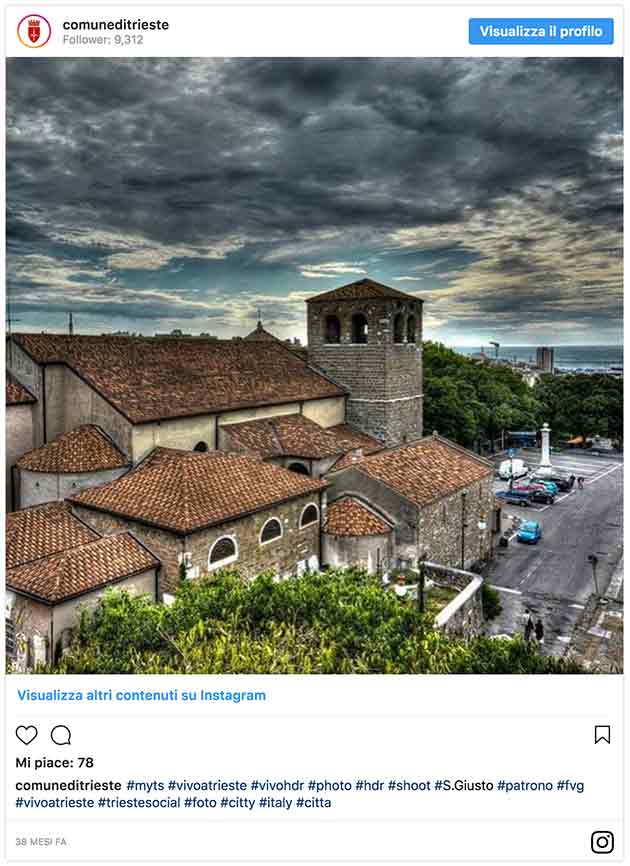
The Cathedral of San Giusto is the most important Church in Trieste and is located on the homonymous hill overlooking the city.
The Church represents the result from the union of the Church of Santa Maria and the one dedicated to San Giusto, occurred between 1302 and 1320.
The linear facade is embellished with a big gothic rose window and with a big central gate with some elements from a Roman funeral stele.
The commemorative plaque above the gate mentions the Austro-English bombardment in 1813 against the Napoleonic troops hiding in the nearby Castle.
Many cannonballs are visible in the bell tower wall, containing also the rests of a Roman temple and a niche with the statue of S. Giusto.
Inside the Cathedral you can see 5 naves with wonderful frescos from the Venetian school. Also the central nave is decorated with a mosaic (Christ between the saints Giusto and Servolo) dated at the end of the 13th century.
On the left of the Cathedral you can reach the Baptistery and the Museum with the Treasure containing also the “halberd of S. Sergio” brought in Trieste by the survivors from the first Crusade.
5 - The Risiera di San Sabba in Trieste
It could seem an unusual choice to insert a Fascist concentration camp in a touristic itinerary.
But if it is true that travelling means discovering and getting awareness of the past, everybody who passes through Trieste should visit the Risiera di San Sabba: it is an former Nazi sorting camp, one of the few out of Poland and Germany.
Factory for the rice husking from 1913 to 1943, after the 8th of September (day of the armistice), Nazis transformed it in an internment camp for the deportation and the elimination with arms, or in Crematory, of hostages, partisans, political prisoners and Jews.
More than 3.500 people were killed and 8.000 deported in Extermination camps in the north of Europe. The chimney stack and the Crematory was later blown up by the Nazis in the desperate attempt to hide their crime, but their presence was testified by the survivors.
The Risiera today is a Museum where the names of the sections recall the terrible function of that place: the “Death Cell“, the “micro-cells“, where people were squashed as animals, the “Cross room”..
6 - Vittoria Light
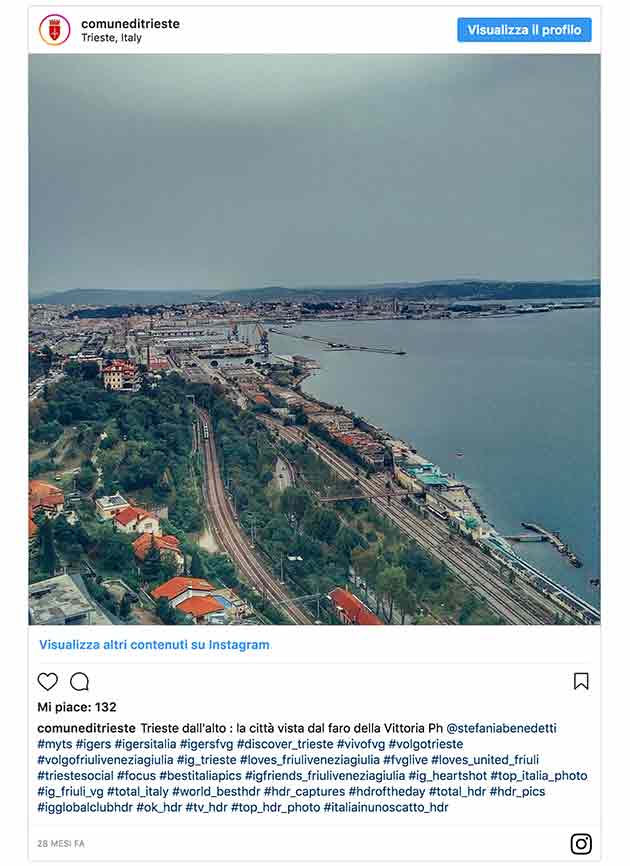
As every self-respecting seaside town, also Trieste has its lighthouse illuminating down the gulf and the port..
The Vittoria Light is a monument full of symbols, a perfect place to look at Trieste from a different point of view.
Built in 1923, during the Fascism, it commemorates the Italian sailors fallen in the World War I, but it’s evident also the celebration of the Italian victory against the Austro-Hungarian Empire.
The lighthouse is built where first was rising an Austrian fortress and the anchor fixed in the stone is the one of the Audace: the first freed destroyer ship to enter in the port of Trieste.
On the basement you’ll find the inscription created by Gabriele D’Annunzio “Shine and remember the dead in the sea”.
At the entrance of the lighthouse you can see two bullets of the Austro-Hungarian battleship Viribus Unitis, sunk by the Marina Italiana, which anchor chain encircle the flowerbed at the base of the lighthouse.
At the top of the lighthouse you can see the Vittoria Alata (The Winged Victory), a statue of more than 7 metres holding a laurel wreath in her right hand and a torch in her left hand. In order to protect it from the strong Bora wind, it was projected with a complex inside mechanism that makes “flapping” (imperceptibly) the wings, so it can absorb the wind gusts.
Right under the statue you see the lighthouse, still the strongest of all the Adriatic sea.
7 - Grotta Gigante
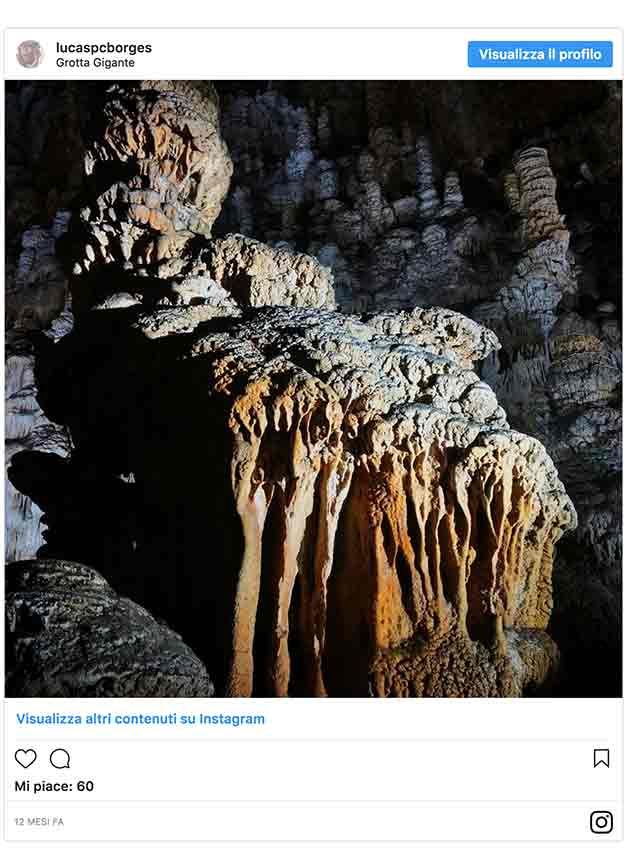
Grotta Gigante (Giant Cave) in Trieste is an immense Karst cave holding the world record for the biggest natural hall.
Nature took more than 10 millions of years to create this natural spectacle, but it’s just a bit more than a century that men discovered it and had the possibility to visit it. Casually discovered in 1890, only in 1908 it was appreciated by the first tourist visitors.
You get inside by a natural door and you go down until the Grande Galleria, at around 80 metres of depth. The gallery is formed by a unique space: 98,50 metres of height, 167,60 metres of length and 76,30 metres of width.
In this hall, full of infinite shades of colours, you can see stalagmites, stalactites and castings of calcium carbonate from the rain water. The most impressive stalagmite is the Colonna Ruggero, 12 metres tall.
At the centre of the cave is located the Geophysics Research Station of the Università degli Studi di Trieste, studying the movements of Earth’s crust.
At the end you come up through the Sentiero Carlo Finocchiaro reaching an extraordinary panoramic viewpoint at 95 metres of height.
8 - The Opicina Tram
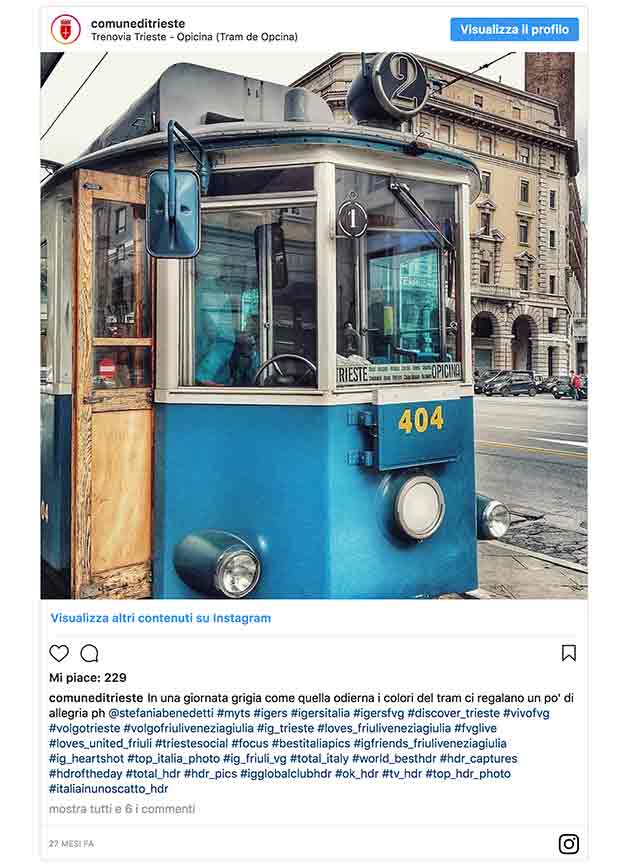
The Opicina Tram is a little jewel that allows you to admire one of the most beautiful panoramas of Trieste, the one from the Obelisco, located in the homonymous district.
It’s 110 years that the Opicina Tram or de Opicina (as called by the people from Trieste), speeds through the centre of Trieste and goes up to 348 metres on the high ground of the Carso, overlooking the city.
The trip starts slowly from Piazza Oberdan, but immediately the rise become very interesting. We suggest you to get off a little bit before the last stop Opicina in order to enjoy the sight of the Adriatic sea from above.
The Obelisco stop is recommended for those who want to walk along the via Napoleonica, a panoramic street bringing (after 4 km) to the Santuario Mariano, called by the people from Trieste the "formaggino" (the cheese triangle) because of its odd shape.
Those who decide to walk the last stretches can reward themselves sitting on a table in one of the Osmizze, the spartan trattorias with not many tables where the farmers cook local culinary dishes and sell their home-made wine.

